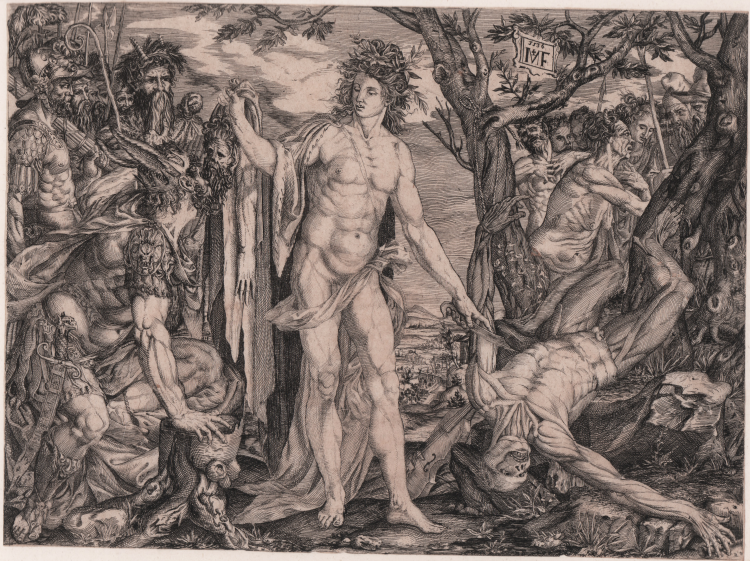




| Reference: | S36550 |
| Author | Anonimo |
| Year: | 1585 |
| Measures: | 303 x 225 mm |



| Reference: | S36550 |
| Author | Anonimo |
| Year: | 1585 |
| Measures: | 303 x 225 mm |
Etching, circa 1585, signed with the artists monogram and dated in plate at upper right: 1536 / MF. After Melchior Meier.
Anonimous copy, in reverse, of a Melchior Meier’s engraving, 1581.
A very good impression, printed with tone on contemporary laid paper, laid down on antique mounting, very good condition.
It features Apollo triumphantly holding Marsyas' removed skin.
This stunning scene draws on two entertaining episodes from Ovid’s Metamorphoses. The section on the left draws on Ovid’s account of the punishment inflicted on the satyr Marsyas for his boast that his musical talents surpassed those of the god Apollo. Elsewhere, Ovid relates a musical contest between the Arcadian god Pan and Apollo, in which Apollo transforms Midas’s ears into those of a donkey for preferring Pan’s tunes. Meier’s representation skilfully weaves together these twomythological tales, depicting the flayed Marsyas on the left, while the god mocks the donkey-eared Midas with Marsyas’ flayed skin on the right.
Melchior Meier made about ten engravings, including ones after paintings by Titian and portraits of the Medici Duke. In 1581 he dedicated an engraving of the Flaying of Marsyas to Francesco I; Duke of Florence.
The engraving is the presumed model both for a painting now in Arezzo and for this etching.
It has been proposed that Melchior intended a compliment to Duke Francesco as the Apollo of the Florentine art scene. However, subjects as Apollo flaying Marsyas and the martyrdom of St. Sebastian became increasingly popular after the appearance of Vesalius’ book of 1543 since they afforded artists the opportunity of combining a display of their anatomical knowledge with a standard artistic subject.
The depiction of mighty Apollo in the centre of the engraving shows the unmistakable influence of the Apollo Belvedere, one of the most famous of the classical sculptures that were studied by Renaissance artists, although, perhaps due to his northern sensibility, Melchior really missed the niceties of the statue’s stance and the modestly draped the figure as well. In accordance with late sixteenth - century taste, the figure is more evidently muscular than the original.
It is generally accepted that the etching copies the engraving and that the date should be understood either as an error or a falsification.
Melchior is known to have varied his monogram and to have used MF for Melchior Fecit.
|
The Simple Art, n. 31, pp. 56-57; Nagler, IV, p. 562, no.1802; Hollstein 7.II
|
Anonimo
|
The Simple Art, n. 31, pp. 56-57; Nagler, IV, p. 562, no.1802; Hollstein 7.II
|
Anonimo